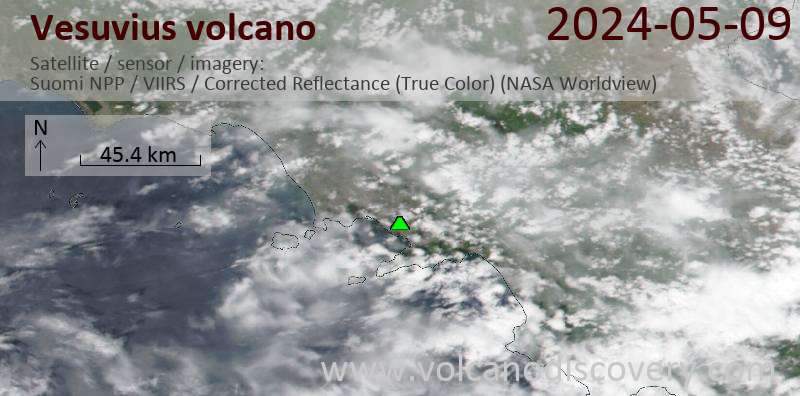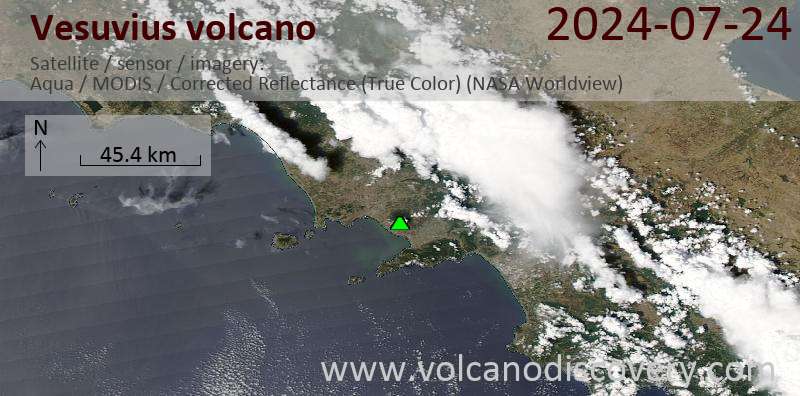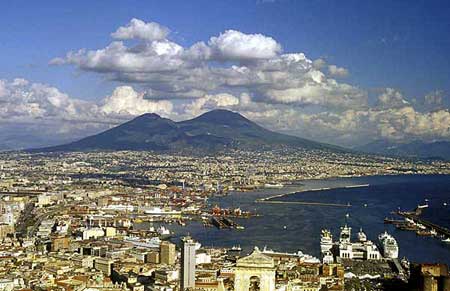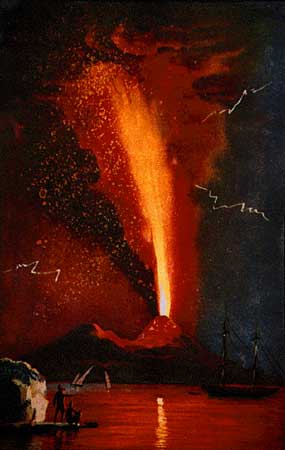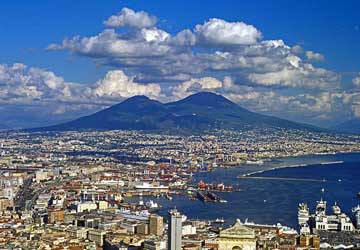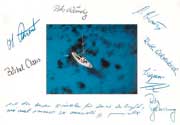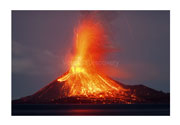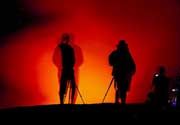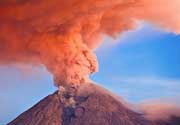Vesuvius Volcano
Updated: 16. Apr. 2024 11:06 GMT -
Stratovolcano 1281 m
Italien, 40.82°N / 14.43°E
Aktueller Status: normal / ruhend (1 von 5)
Italien, 40.82°N / 14.43°E
Aktueller Status: normal / ruhend (1 von 5)
Last update: 9 Mär 2022 (occasional swarms of tiny earthquakes)
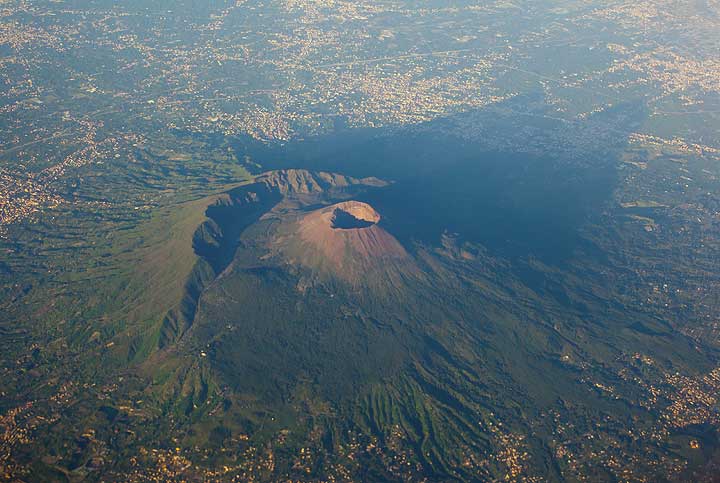
Vesuvius volcano near Naples, Italy, seen from the air. The rim of the remnant of the older Somma volcano which collapsed in the 79 AD Plinian eruption is clearly visible to the left of the new Cono Grande cone with its crater.
[smaller] [larger]
1. Plinian (such as the 79 AD Pompeii eruption): extremely large explosive eruptions producing several to several tens of cubic km of magma in a very short time.
2. Sub-Plinian explosive eruptions (such as the 1631 eruption). They are similar in style, but smaller than true Plinian events.
3. Strombolian and Vulcanian eruptions (several examples during the 1631-1944 period, e.g. 1906 and 1944). Such eruptions produce local heavy tephra falls, small pyroclastic flows, as well as large fire fountains and lava flows.
4. The smallest, but most frequent type of activity observed at Vesuvius is persistent Strombolian to Hawaiian-style activity that prevailed during much of the period between 1631 and 1944. This activity is usually limited to the central crater, and sometimes to flank vents. Lava flows and lava fountains have been frequently observed during such periods of activity.
Ausbrüche des Vesuvius: 1796 - 1822, 1824 - 1834, 1835 - 1839, 1841 - 16 February 1850, 1854 - 1855, 1855 - 1861, 1864 - 1868, 1870 - 1872, 1875 - 1906, 1913 - 4 April 1944
Letzte Erdbeben in der Nähe
| Uhrzeit | Mag. / Tiefe | Entfernung / Ort | |||
| 14. Apr. 10:01 (Rome) | 3.0 2.4 km | 24 km westlich | Info | ||
| 14. Apr. 09:46 (Rome) | 3.1 2.8 km | 24 km westlich | Info | ||
| 14. Apr. 09:44 (Rome) | 3.7 2.5 km | 24 km westlich | Info | ||
| Donnerstag, 4. April 2024 GMT (1 Beben) | |||||
| 4. Apr. 07:33 (Rome) | 3.2 2.3 km | 26 km westlich | Info | ||
| Dienstag, 9. April 2024 GMT (1 Beben) | |||||
| 9. Apr. 22:32 (Rome) | 2.8 2.8 km | 23 km westlich | Info | ||
| Sonntag, 14. April 2024 GMT (1 Beben) | |||||
| 14. Apr. 09:57 (Rome) | 2.7 1 km | 24 km westlich | Info | ||
Beschreibung
Vesuvius ("Vesuvio" in Italian) is probably not only the most famous, but also one, if not the most dangerous volcano on Earth. The first eyewitness account of a volcanic eruption that has been preserved has come to us from Vesuvius: In 79 AD, after a century-long slumber, the volcano woke up with terrifying power in an eruption that buried several Roman towns like Pompeii and Herculaneum under several meters of ash. Today, parts of these cities have been excavated and are among the most remarkable archaeological sites of the world, allowing us to have an excellent view on Roman life and culture, where time and life had been frozen in a moment.Geologically, Mt. Vesuvius, or more correctly the Somma-Vesuvius complex, is about 400,000 years old, as dating of lava sampled drilled from over 1,300 m depth have shown. Present-day Vesuvius is a medium-sized typical stratovolcano volcano reaching a height of 1,281 m a.s.l. It comprises the older volcano, the Somma, whose summit collapsed (likely during the 79 AD eruption), creating a caldera, and the younger volcano, Vesuvius, which since then has re-grown inside this caldera and formed a new cone. Although in a dormant phase at present, Vesuvius is an extremely active volcano and particular for its unusually varied style of activity: it ranges from Hawaiian-style emission of very liquid lava, extreme lava fountains, lava lakes and lava flows, over Strombolian and Vulcanian eruptions to violently explosive, Plinian eruptions that produce large pyroclastic flows.
When one thinks about Vesuvius volcano today, one aspect is eminent: due to the dense population surrounding it, and ever climbing higher and higher up on its slopes, it is certainly among Earth's most dangerous volcanoes. It is estimated that ore than 500,000 people live in the zone immediately threatened by a future eruption. When this happens is not known; it is possible that Vesuvius has entered into one of its typically century-long lasting phases of dormancy, but volcanoes can be unpredictable. The situation in the Gulf of Naples is further complicated by the presence of another highly active, and potentially as dangerous volcano: the Campi Flegrei, located immediately under a large part of the modern city of Naples proper.
Vesuvius Volcano Photos
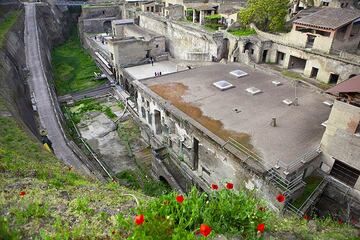
Die Ausgrabungen der römischen Stadt Ercolaneo durch pyroklastische Ströme von Vesuvius Vulkan in der 79 n. Chr. Eruption begraben. (Photo: Tom Pfeiffer)
Latest satellite images
Vesuvius Volcano Tours
Süditalien
Italiens Vulkane - Vom Vesuv zum Ätna
14-tägige Studienreise zu den aktiven Vulkanen Italiens
14 Tage (13 Nächte) - Leicht bis mittel
Preis 3890 €
Preis 3890 €
3.-17. Okt 2025
Bay of Naples (Italy)
Italy's Volcanic Soul - the Bay of Naples
8-day tour in the Bay of Naples: Vesuvius, Pompeii, Erculaneum, Phlegrean Fields, and Ischia Island
8 days / 7 nights - Leicht bis mittel
Preis 3250 €
Preis 3250 €
Mai or June 2024





